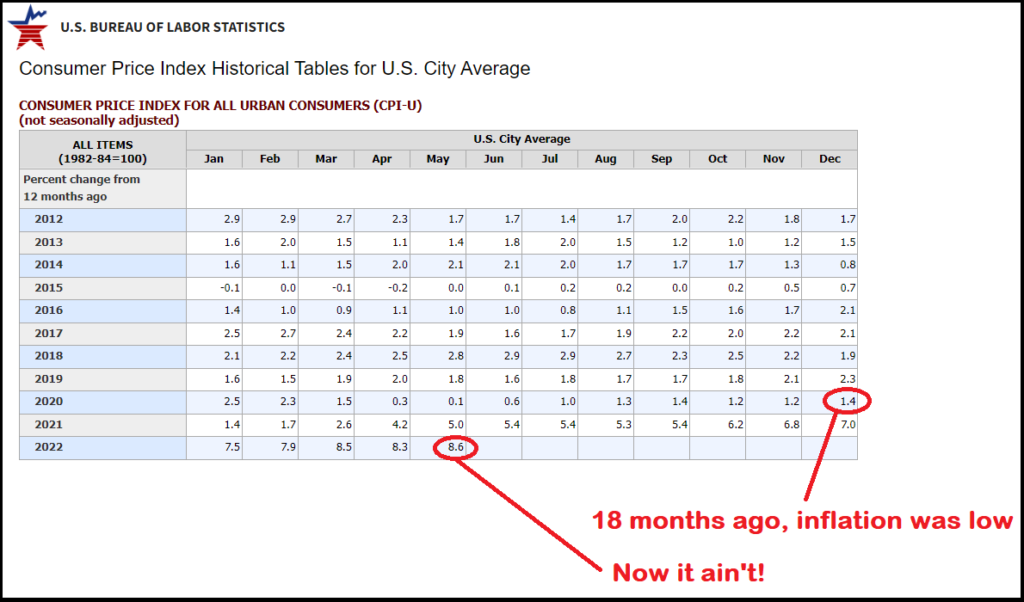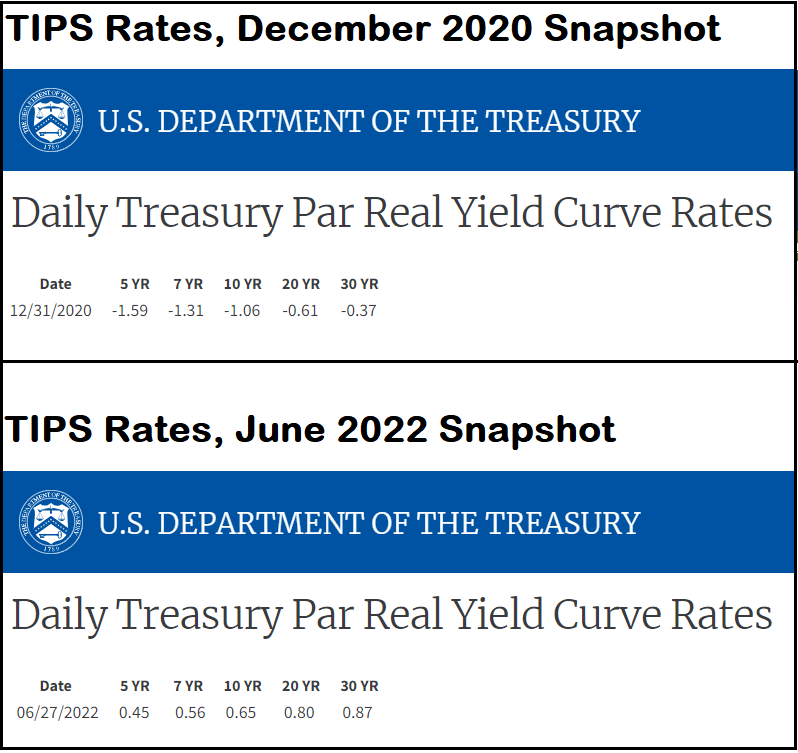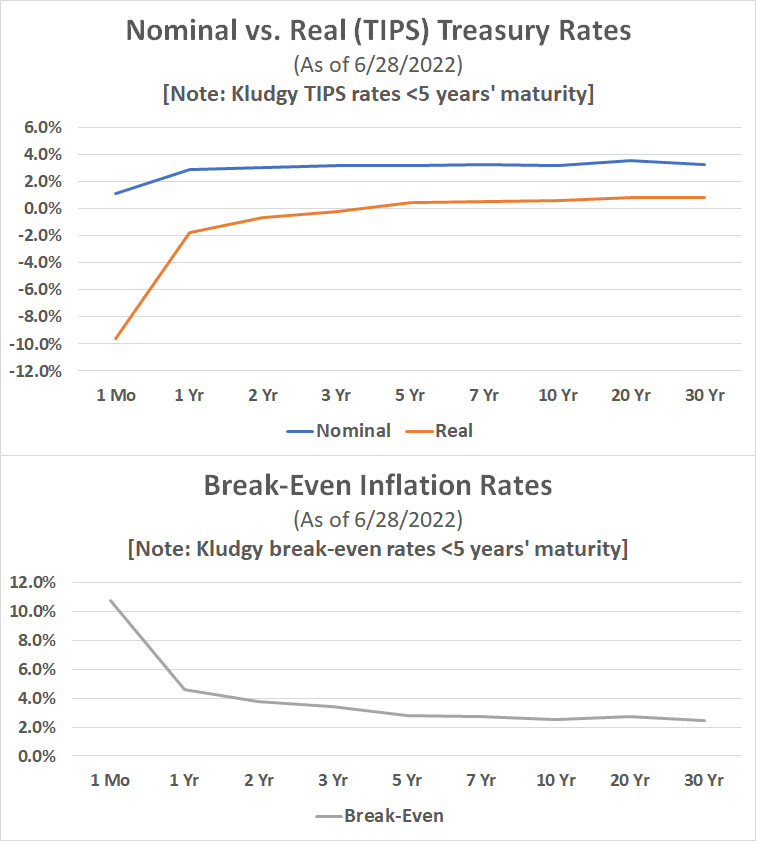Here’s how things normally work:
- When a product is unpopular and nobody thinks they need it, it is inexpensive to acquire.
- If the product later becomes highly popular and everybody thinks they need it, its price goes up, probably by a lot.
But if the “product” in question is a multi-year stream of inflation-protected income (e.g., to preserve your buying power in retirement, hint-hint), here is what has happened over the last 18 months or so:
- Back then inflation was low, the idea of inflation protection was rarely discussed, and the cost to purchase inflation-protected income via Treasury Inflation-Protected Securities (TIPS) was historically expensive.
- Now inflation is at 40-year highs, everybody is worried about protecting their buying power, and the cost to purchase a multi-year stream of inflation-protected income has become…a lot less expensive. Say what?!
In the past, when I would suggest[1] that locking in a stream of inflation-protected income was probably a good idea for many folks, especially (near-)retirees, the response was typically something like, “Protect against infla-what-now?” After all, as of December 2020, the 12-month inflation rate was a measly 1.4%, and it had been below 3% for nine years. Incredulity was compounded by the fact that real interest rates were negative across the entire yield curve, such that the cost to purchase 20-30 years of inflation-protected income via TIPS laddering or duration-matching was about as high as it had ever been.

https://www.bls.gov/regions/mid-atlantic/data/consumerpriceindexhistorical_us_table.htm
Fast-forward to today: The most recent inflation print is 8.6%, the highest rate since before Reagan wrapped up his first year in office, before Chariots of Fire won Best Picture, and before I had my one-year wellness exam.[2] So sure, now everybody is talking about the importance of finding ways to protect the buying power of your dollars.[3] And yet, remarkably, real rates (i.e., interest rates before adjustments for inflation) are now positive across most of the yield curve, and the cost to purchase a long-term stream of income with TIPS is substantially lower than it was 18 months ago.
You’re welcome to take my word for it and stop here, since that is the rather remarkable fact I wished to convey. But if you want more details on how that can be, then read on! (Or split the difference and skip to some basic advice.)
Background: The “What”
To explain how this works, we’ll be talking about TIPS rates. I’ll admit it isn’t immediately obvious how TIPS bonds translate to inflation-adjusted income, given their individual maturity dates, their volatile prices pre-maturity, et al. I’ll get another article up soon that describes how Round Table uses TIPS to craft an inflation-adjusted income stream [UPDATE (8/9/2022): Here it is!]; for the initiated, the process involves either dynamic duration matching or bond laddering, or both.
The basic notion, though, is this: The higher the real yields offered by TIPS securities, ranging from short-term to long-term maturities, the less expensive it is to purchase inflation-protected income by buying a spectrum of TIPS.
Check out this comparison of TIPS yields from December 2020 vs. June 2022, from the Treasury Department’s interest rates data repository.

https://home.treasury.gov/policy-issues/financing-the-government/interest-rate-statistics
In late 2020, TIPS rates were negative across the board. These are real interest rates, so this does not mean a buyer would be locking in a negative return. For example, if a one-year TIPS bond has a yield to maturity[4] of -0.5%, but inflation accruals for the year are 3%, then the total return on the bond will be about 2.5%.[5]
Nonetheless, those 2020 yields meant that for all timeframes ranging from the short-term[6] to the long-term, you would have to pay more than a dollar in late 2020 to get back a 2020 dollar’s worth of inflation-adjusted buying power in a future year. Insofar as the correct lens on this transaction is as inflation insurance,[7] I would argue that the benefit could be worth the cost for many folks even then.[8] Still, the cost of locking in a stream of inflation-protected income in late 2020 was mighty steep by historical standards.
In the 18 months since then, the trailing 12-month inflation rate has more than sextupled to 8.6%. Considering that the market bakes the magnitude of expected future inflation into the price of TIPS instruments (more on that below), you’d think the price would be even higher now than it was back then. Maybe a lot higher! But instead the yields on TIPS have mostly risen, and have actually gone positive in the intermediate-to-long term, implying significant reductions in the cost of inflation-protected income!
The cost for the shortest maturities has actually risen, due to immediate inflation pressure, but for someone looking to build, say, 20-30 years of inflation-protected income, decreased medium-to-long-term costs would far outweigh increased short-term costs. Some examples:
- Using the calculation methodology that we employ for real-world clients,[9] we can estimate that the cost to lock in 30 years of inflation-protected income with TIPS declined by nearly 20% (!) from late December 2020 to late June 2022.
- Perhaps more apples-to-apples, if inevitably more complicated: Suppose in December 2020 you were looking to lock in real income from January 2026 through December 2050. But it slipped your mind for 18 months and now in June 2022 you want to lock in the same real dollar amount of income over the same 25-year timeframe. The Consumer Price Index has risen 12.2% since then, so you would need to purchase 1.122 times as many nominal dollars of current face value to get the same amount of inflation-protected income. Yet we still calculate that this would cost more than 20% less as of June 2022. And that’s a 20% lower price in nominal terms…the cost is about 30% less in real terms.[10]
Background: The “How?” and “Why?”
So the cost of TIPS has come down even as inflation has gone up. There are two basic reasons for this surprising outcome:
1. Interest rates in general have risen significantly
In other words, virtually all fixed income products have declined in price, especially in the first half of 2022. (Remember, higher interest rates on bonds = lower bond prices, all else equal.) The most basic view is that TIPS have simply participated in this repricing.
But that is perhaps a bit strange? After all, why did interest rates rise? Wasn’t that due to inflation in the first place?
Well, first of all, the markets make their oracular pronouncements through the price-setting mechanism alone. Despite what you may read nearly every day in the financial news, market moves do not come with little tags explaining why they occurred, so the best we can offer is educated guesswork. With that caveat firmly entrenched, in the opinion of this humble[11] commentator, it seems pretty darn reasonable to assume rising rates are at least partly a direct[12] and indirect[13] response to elevated inflation.
But to the extent higher interest rates are caused by higher inflation, those two effects can cancel out in the price of TIPS. Real interest rates (for TIPS) are a function of both nominal interest rates (for normal, non-inflation-adjusted Treasurys[14]) and inflation expectations.[15]
For example, as of this writing, while a nominal one-month Treasury bill has an annualized yield of +1.2%,[16] a one-month-ish[17] TIPS security has an annualized real yield of -9.6%[18]—a difference that is entirely explained by the extremely high monthly CPI number printed for last month, since the total return of that TIPS security will include the real rate plus accruals for two-month-lagged inflation.
If market-implied inflation expectations remained high heading out into the future, subtracting higher expected inflation rates from higher nominal interest rates could theoretically have left real rates in basically the same place. But it turns out…
2. Future inflation expectations drop off remarkably quickly
Looking at the difference between nominal Treasury rates and real TIPS rates, we can calculate what is known as the “break-even” inflation rate—i.e., the rate that inflation would have to be in order for nominal Treasurys and TIPS to ultimately produce the same total return.
We can compare the TIPS rates above to nominal rates from the Treasury website. For example, the 30-year “constant maturity Treasury” (CMT) rate stands at 3.31% for nominal bonds and 0.87% for TIPS, yielding a break-even inflation rate of just 2.44%. (Note that even this should probably be viewed as an upper limit for the market’s inflation expectations, since nominal Treasury yields likely incorporate a premium for inflation risk.)
Okay, so 2.44% is the break-even inflation rate over the next thirty years, but surely inflation expectations are higher in the intermediate term? Technically yes, but not really. For example, the five-year break-even inflation rate is still just 2.79%!

https://home.treasury.gov/policy-issues/financing-the-government/interest-rate-statistics (data)
Unfortunately, the Treasury’s website doesn’t calculate par yields for TIPS maturing in less than five years.[19] One option to get accurate data on shorter-term constant-yield maturities would be to pay about $25,000 for a Bloomberg terminal license. I considered that for about 0.68 seconds,[20] and then I decided that a slightly fudgy calculation using yield-to-maturity for shorter-term TIPS would have to do.
That said:
- The three-year-ish[21] TIPS yield is -0.2%, vs. 3.2% for nominal Treasurys—a 3.4% break-even inflation rate.
- The two-year-ish[22] TIPS yield is -0.7%, vs. 3.1% for nominal Treasurys—a 3.8% break-even inflation rate.
- The one-year-ish[23] TIPS yield is -1.7%, vs. 2.9% for nominal Treasurys—a 4.6% break-even inflation rate.

https://home.treasury.gov/policy-issues/financing-the-government/interest-rate-statistics
and Wall Street Journal, https://www.wsj.com/market-data/bonds/tips (data)
These break-even inflation rates are for the full timeframe, so for example that one-year break-even rate includes the double-digit annualized inflation accruing at present. Yet the markets are predicting—and thus are only charging investors for—sub-5% inflation over the next twelve months, and even less over longer periods!
What we recommend you do and don’t do with this information
While I confess it surprises me to see the market’s implied inflation expectations drop off so quickly, I have learned to be humble[24] with respect to market prices/predictions. The TIPS price represents the collective wisdom of a myriad of sophisticated participants in the Treasury markets. Round Table would not recommend viewing the market’s surprisingly (to me! what do I know?!) low inflation projections as an opportunity to “beat the market” by buying TIPS.
However, the function of TIPS as a means to generate inflation-protected income is something we’ve always believed in as a powerful tool in the retirement investment toolbelt. Relatively low break-even rates plus significantly higher nominal rates combine to make this inflation insurance tool less expensive than it was before inflation got hot. This gives retirees and near-retirees[25] an opportunity to purchase a stream of inflation-protected income at a price that is, remarkably, lower than it was before inflation took off.
Final Note
Again, we’ll get another blog post up soon that explains in more detail how we go about building an inflation-protected income stream for our clients [UPDATE (8/9/2022): Here it is!], but it is unavoidably somewhat complex. If this technique, as part of a broader goals-based investing solution, would be of interest to you, we would welcome the chance to speak with you about your specific financial plan.
[1] Which I have done for many years. I didn’t just jump on this bandwagon recently! Ask anyone…
[2] And I’m getting old. Just ask my knees.
[3] I’m not bitter.
[4] Note that “yield to maturity” includes both coupon payments and, more importantly, the return of par/face value at maturity. As with the word “income” itself, a bond’s “yield” is easily and often confused or conflated with the size of the coupon payment. (The specific term “current yield” references exactly that.) But for many bonds, the return of par value at maturity is the single biggest “yield” event, and for our purposes the return of (inflation-adjusted) face value at maturity is the driver of (inflation-protected) income via TIPS. In fact, as noted in the next footnote, the “yield to maturity” math would be simpler if there were no coupon payments!
[5] The word “about” is brought to you by the complications of coupon payments in the interim. TIPS coupons are mostly quite small at present, though, and the simple math (total return = real yield + accrued inflation) is awfully close to correct.
[6] The Treasury site doesn’t calculate par real yields of less than five years, but shorter-term TIPS all had negative real yields back then as well.
[7] Technically speaking, TIPS are an inflation hedge rather than inflation insurance, which is a distinction I will not bother to define here and will promptly ignore in the next footnote. Chalk this footnote up to a compulsive commitment to pedantic precision.
[8] Here’s an analogy: You hope to lose money on term life insurance—preferably everything you spend! The insurance company’s willingness to sell it to you implies that you can also expect to lose money on average. But insofar as your untimely death would create hardship for your loved ones, that negative-expected-return purchase can absolutely be the right choice nonetheless! A similar argument could apply to anyone—especially those in or near retirement—for whom inflation poses a potential risk to their ability to pay bills, buy groceries, etc.
[9] We would be happy to run such a real-world calculation on your behalf, but we’ll spare our readers the real-world complexity of how it works in this article. If either real-world information is of interest, though, feel free to contact us!
[10] I know, I know, inflation adjustments and inflation terminology are so bloomin’ complicated. I’m sorry. (I can’t help myself, but at least I’m sorry.)
[11] -ish
[12] At least one “direct” argument might look like this: 1. Inflation is high. 2. That means a dollar in the future will be worth significantly less than a dollar today. 3. Consequently, the market will demand a higher expected return (in nominal dollar terms) between now and the future. 4. Partly that occurs through setting higher interest rates on bonds.
[13] The “indirect” portion might look like this: 1. Inflation is high. 2. The Fed will have to raise the Fed Funds rate to fight inflation. 3. The market knows that, so it proactively raises a bunch of other interest rates in advance. This is simplistic, to say the least, but not crazy.
[14] A note on spelling: “Treasuries” vs. “Treasurys” is a debate. I picked one. I’d also rather stop using the capital “T” everywhere, but all the folks on the interwebs seem to disagree with me on that one.
[15] It’s probably a better model to say that nominal rates are a function of real rates, plus inflation expectations plus an inflation risk premium. Again, compulsive pedantry… Causality aside, though, algebra says the function works both ways.
[16] Source: https://home.treasury.gov/resource-center/data-chart-center/interest-rates/TextView?type=daily_treasury_yield_curve&field_tdr_date_value=2022
[17] See below for the source of the “ish.” This is really the yield for a TIPS security maturing on 7/15/2022, so rather less than a month away.
[18] Source: https://www.wsj.com/market-data/bonds/tips
[19] This is presumably because TIPS are only issued in maturities of five years or more. But if anyone at the Treasury Department is reading this, publicly available off-the-run short-term TIPS CMT yields would sure be nice!
[20] For an android, that is nearly an eternity.
[21] For a bond maturing on 7/15/2025.
[22] For a bond maturing on 7/15/2024.
[23] For a bond maturing on 7/15/2023.
[24] More than “ish”
[25] Or anyone, of course, but especially them.
DISCLOSURES: All content is provided solely for informational purposes and should not be considered an offer, or a solicitation of an offer, to buy or sell any particular security, product, or service. Round Table Investment Strategies (Round Table) does not offer specific investment recommendations in this presentation. This article should not be considered a comprehensive review or analysis of the topics discussed in the article. Investing involves risks, including possible loss of principal. Despite efforts to be accurate and current, this article may contain out-of-date information; Round Table will not be under an obligation to advise of any subsequent changes related to the topics discussed in this article. Round Table is not an attorney or accountant and does not provide legal, tax or accounting advice. This article is impersonal and does not take into account individual circumstances. An individual should not make personal financial or investment decisions based solely upon this article. This article is not a substitute for or the same as a consultation with an investment adviser in a one-on-one context whereby all the facts of the individual’s situation can be considered in their entirety and the investment adviser can provide individualized investment advice or a customized financial plan.
The data shown in this article is for informational purposes only and should not be considered as an investment recommendation or strategy, or as an offer to buy or sell any particular security, product, or service. Past performance may not be indicative of future results. While the sources of data included in any charts/graphs/calculations are believed to be reliable, Round Table cannot guarantee their accuracy.
